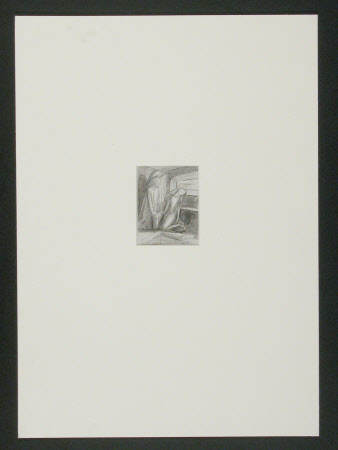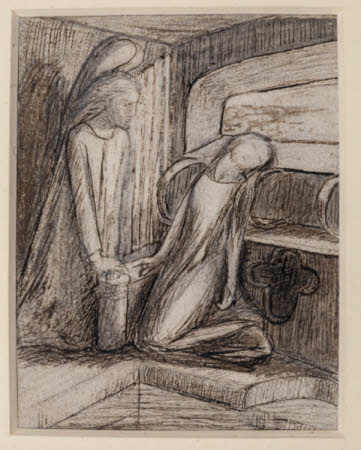St Cecilia
Elizabeth 'Lizzie' Eleanor Siddal, Mrs Dante Gabriel Rossetti (Holborn 1829 – Chatham Place, London 1862)
Category
Art / Drawings and watercolours
Date
1860
Materials
Pen and ink on paper
Measurements
100 mm (H); 7.80 mm (W); 535 mm (H); 380 mm (W)
Order this imageCollection
Wightwick Manor, West Midlands
NT 1288032
Summary
Pen and ink drawing - Pencil, pen and brown ink. An angel appearing to a fainting St Cecilia, who leans against a wooden bench. Glued to white paper surround, large cream card mount. Information from Beyond Ophelia, 2018 Lizzie Siddal exhibition: Three sketches of St Cecilia were bought by the Manders. Siddal experiments with the scene; in this drawing she has bought St Cecilia and the angel closer together. St Cecilia, the patron saint of music, is shown with organ pipes in all 3 drawings. The subject is based on Tennyson's poem The Palace of Art in which a palace is full of scenes from art, including the angel appearing to St Cecilia. Lizzie suggests in this image that art was an activity separate from the outside world and compares the devotion of art to religion. In the Victorian era St. Cecilia captured the imagination of a variety of artists, and as the patron saint of music is often depicted with musical instruments. Saint Cecilia is a symbol of steadfast virtue and heroism. Cecilia lived in the 2nd or 3rd century A.D. and belonged to a noble Roman family. She took a vow of chastity but was forced to marry Valerian, a pagan man. Once they were married, St. Cecilia explained her religious beliefs to her husband and he was so convinced by her that he agreed to be baptised. He even persuaded his brother to join him in his newfound Christian faith. Like many saints, St. Cecilia suffered a painful death as a result of her enduring Christian faith. Tennyson’s poem The Palace of Art was the inspiration for these drawings. In the poem a woman creates a palace of scenes and memories for her to live in, including a room where St Cecilia and the angel are: ‘I built my soul a lordly pleasure-house, / Wherein at ease for aye to dwell.’ ‘My soul would live alone unto herself / In her high palace there.’ ‘Full of long-sounding corridors it was / over-vaulted grateful gloom, / Thro' which the livelong day my soul did pass, / Well-pleased, from room to room.’
Provenance
Probably Charles Fairfax Murray; by descent to his son Arthur R. Murray; purchased Sotheby's 15 February 1961, part of lot 6 (an album of drawings and sketches mostly by Elizabeth Siddal); purchased by Sir Geoffrey Mander, c.£120-170 the lot; (Sir Geoffrey Mander later sold 6 of the pictures in the purchased lot to Jeremy Maas, including Siddal's Lady of Shalott); transferred to the National Trust on the death of Rosalie Glynn Grylls, Lady Mander (1905 - 1988)
Marks and inscriptions
By Lizzie R Tennyson - St Cecilia. (signed in pencil)
Makers and roles
Elizabeth 'Lizzie' Eleanor Siddal, Mrs Dante Gabriel Rossetti (Holborn 1829 – Chatham Place, London 1862), publisher


